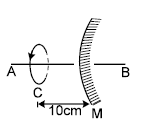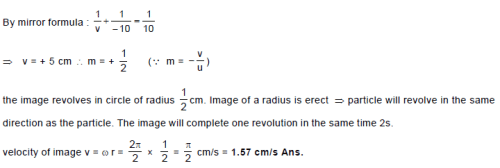JEE Exam > JEE Questions > A particle revolves in clockwise direction (a...
Start Learning for Free
A particle revolves in clockwise direction (as seen from point A) in a circle C of radius 1 cm and completes one revolution in 2 sec. The axis of the circle and the principal axis of the mirror M coincide. Call it AB. The radius of curvature of the mirror is 20 cm. Then the direction of revolution (as seen from A) of the image of the particle and its speed is

- a)Clockwise, 1.57 cm/s
- b)Clockwise, 3.14 cm/s
- c)Anticlockwise, 1.57 cm/s
- d)Anticlockwise, 3.14 cm/s
Correct answer is option 'A'. Can you explain this answer?
| FREE This question is part of | Download PDF Attempt this Test |
Verified Answer
A particle revolves in clockwise direction (as seen from point A) in a...


|
Explore Courses for JEE exam
|

|
Similar JEE Doubts
A particle revolves in clockwise direction (as seen from point A) in a circle C of radius 1 cm and completes one revolution in 2 sec. The axis of the circle and the principal axis of the mirror M coincide. Call it AB. The radius of curvature of the mirror is 20 cm. Then the direction of revolution (as seen from A) of the image of the particle and its speed isa)Clockwise, 1.57 cm/sb)Clockwise, 3.14 cm/sc)Anticlockwise, 1.57 cm/sd)Anticlockwise, 3.14 cm/sCorrect answer is option 'A'. Can you explain this answer?
Question Description
A particle revolves in clockwise direction (as seen from point A) in a circle C of radius 1 cm and completes one revolution in 2 sec. The axis of the circle and the principal axis of the mirror M coincide. Call it AB. The radius of curvature of the mirror is 20 cm. Then the direction of revolution (as seen from A) of the image of the particle and its speed isa)Clockwise, 1.57 cm/sb)Clockwise, 3.14 cm/sc)Anticlockwise, 1.57 cm/sd)Anticlockwise, 3.14 cm/sCorrect answer is option 'A'. Can you explain this answer? for JEE 2024 is part of JEE preparation. The Question and answers have been prepared according to the JEE exam syllabus. Information about A particle revolves in clockwise direction (as seen from point A) in a circle C of radius 1 cm and completes one revolution in 2 sec. The axis of the circle and the principal axis of the mirror M coincide. Call it AB. The radius of curvature of the mirror is 20 cm. Then the direction of revolution (as seen from A) of the image of the particle and its speed isa)Clockwise, 1.57 cm/sb)Clockwise, 3.14 cm/sc)Anticlockwise, 1.57 cm/sd)Anticlockwise, 3.14 cm/sCorrect answer is option 'A'. Can you explain this answer? covers all topics & solutions for JEE 2024 Exam. Find important definitions, questions, meanings, examples, exercises and tests below for A particle revolves in clockwise direction (as seen from point A) in a circle C of radius 1 cm and completes one revolution in 2 sec. The axis of the circle and the principal axis of the mirror M coincide. Call it AB. The radius of curvature of the mirror is 20 cm. Then the direction of revolution (as seen from A) of the image of the particle and its speed isa)Clockwise, 1.57 cm/sb)Clockwise, 3.14 cm/sc)Anticlockwise, 1.57 cm/sd)Anticlockwise, 3.14 cm/sCorrect answer is option 'A'. Can you explain this answer?.
A particle revolves in clockwise direction (as seen from point A) in a circle C of radius 1 cm and completes one revolution in 2 sec. The axis of the circle and the principal axis of the mirror M coincide. Call it AB. The radius of curvature of the mirror is 20 cm. Then the direction of revolution (as seen from A) of the image of the particle and its speed isa)Clockwise, 1.57 cm/sb)Clockwise, 3.14 cm/sc)Anticlockwise, 1.57 cm/sd)Anticlockwise, 3.14 cm/sCorrect answer is option 'A'. Can you explain this answer? for JEE 2024 is part of JEE preparation. The Question and answers have been prepared according to the JEE exam syllabus. Information about A particle revolves in clockwise direction (as seen from point A) in a circle C of radius 1 cm and completes one revolution in 2 sec. The axis of the circle and the principal axis of the mirror M coincide. Call it AB. The radius of curvature of the mirror is 20 cm. Then the direction of revolution (as seen from A) of the image of the particle and its speed isa)Clockwise, 1.57 cm/sb)Clockwise, 3.14 cm/sc)Anticlockwise, 1.57 cm/sd)Anticlockwise, 3.14 cm/sCorrect answer is option 'A'. Can you explain this answer? covers all topics & solutions for JEE 2024 Exam. Find important definitions, questions, meanings, examples, exercises and tests below for A particle revolves in clockwise direction (as seen from point A) in a circle C of radius 1 cm and completes one revolution in 2 sec. The axis of the circle and the principal axis of the mirror M coincide. Call it AB. The radius of curvature of the mirror is 20 cm. Then the direction of revolution (as seen from A) of the image of the particle and its speed isa)Clockwise, 1.57 cm/sb)Clockwise, 3.14 cm/sc)Anticlockwise, 1.57 cm/sd)Anticlockwise, 3.14 cm/sCorrect answer is option 'A'. Can you explain this answer?.
Solutions for A particle revolves in clockwise direction (as seen from point A) in a circle C of radius 1 cm and completes one revolution in 2 sec. The axis of the circle and the principal axis of the mirror M coincide. Call it AB. The radius of curvature of the mirror is 20 cm. Then the direction of revolution (as seen from A) of the image of the particle and its speed isa)Clockwise, 1.57 cm/sb)Clockwise, 3.14 cm/sc)Anticlockwise, 1.57 cm/sd)Anticlockwise, 3.14 cm/sCorrect answer is option 'A'. Can you explain this answer? in English & in Hindi are available as part of our courses for JEE.
Download more important topics, notes, lectures and mock test series for JEE Exam by signing up for free.
Here you can find the meaning of A particle revolves in clockwise direction (as seen from point A) in a circle C of radius 1 cm and completes one revolution in 2 sec. The axis of the circle and the principal axis of the mirror M coincide. Call it AB. The radius of curvature of the mirror is 20 cm. Then the direction of revolution (as seen from A) of the image of the particle and its speed isa)Clockwise, 1.57 cm/sb)Clockwise, 3.14 cm/sc)Anticlockwise, 1.57 cm/sd)Anticlockwise, 3.14 cm/sCorrect answer is option 'A'. Can you explain this answer? defined & explained in the simplest way possible. Besides giving the explanation of
A particle revolves in clockwise direction (as seen from point A) in a circle C of radius 1 cm and completes one revolution in 2 sec. The axis of the circle and the principal axis of the mirror M coincide. Call it AB. The radius of curvature of the mirror is 20 cm. Then the direction of revolution (as seen from A) of the image of the particle and its speed isa)Clockwise, 1.57 cm/sb)Clockwise, 3.14 cm/sc)Anticlockwise, 1.57 cm/sd)Anticlockwise, 3.14 cm/sCorrect answer is option 'A'. Can you explain this answer?, a detailed solution for A particle revolves in clockwise direction (as seen from point A) in a circle C of radius 1 cm and completes one revolution in 2 sec. The axis of the circle and the principal axis of the mirror M coincide. Call it AB. The radius of curvature of the mirror is 20 cm. Then the direction of revolution (as seen from A) of the image of the particle and its speed isa)Clockwise, 1.57 cm/sb)Clockwise, 3.14 cm/sc)Anticlockwise, 1.57 cm/sd)Anticlockwise, 3.14 cm/sCorrect answer is option 'A'. Can you explain this answer? has been provided alongside types of A particle revolves in clockwise direction (as seen from point A) in a circle C of radius 1 cm and completes one revolution in 2 sec. The axis of the circle and the principal axis of the mirror M coincide. Call it AB. The radius of curvature of the mirror is 20 cm. Then the direction of revolution (as seen from A) of the image of the particle and its speed isa)Clockwise, 1.57 cm/sb)Clockwise, 3.14 cm/sc)Anticlockwise, 1.57 cm/sd)Anticlockwise, 3.14 cm/sCorrect answer is option 'A'. Can you explain this answer? theory, EduRev gives you an
ample number of questions to practice A particle revolves in clockwise direction (as seen from point A) in a circle C of radius 1 cm and completes one revolution in 2 sec. The axis of the circle and the principal axis of the mirror M coincide. Call it AB. The radius of curvature of the mirror is 20 cm. Then the direction of revolution (as seen from A) of the image of the particle and its speed isa)Clockwise, 1.57 cm/sb)Clockwise, 3.14 cm/sc)Anticlockwise, 1.57 cm/sd)Anticlockwise, 3.14 cm/sCorrect answer is option 'A'. Can you explain this answer? tests, examples and also practice JEE tests.

|
Explore Courses for JEE exam
|

|
Suggested Free Tests
Signup for Free!
Signup to see your scores go up within 7 days! Learn & Practice with 1000+ FREE Notes, Videos & Tests.























